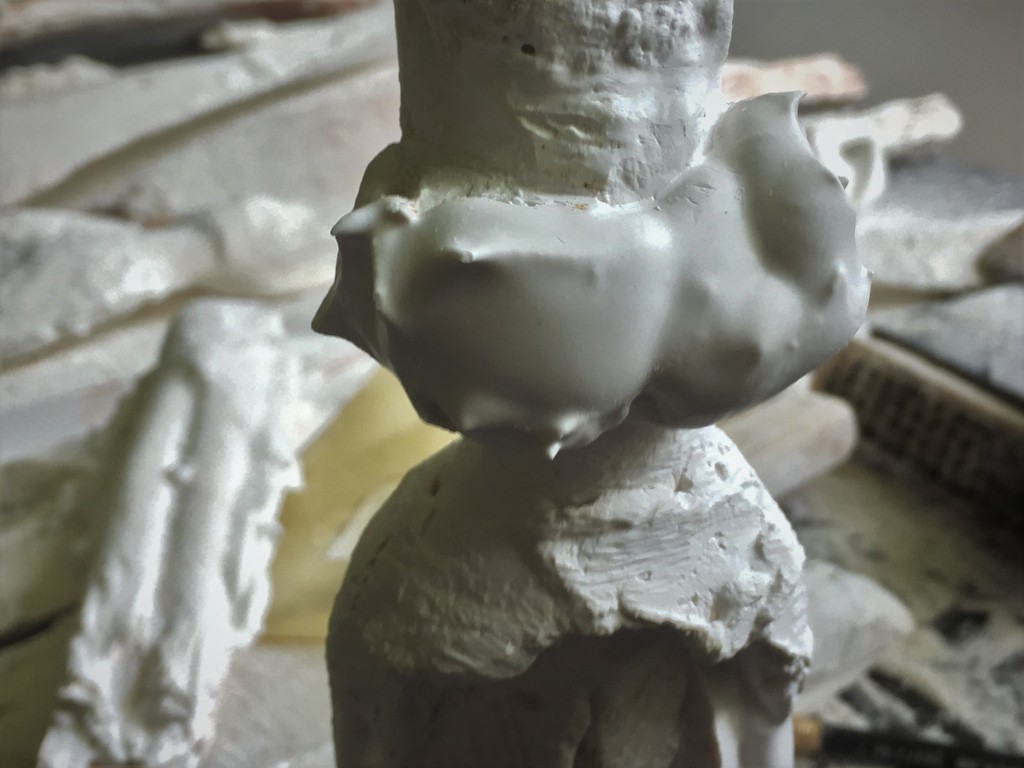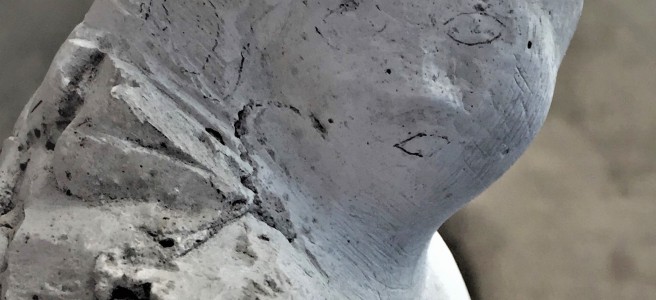by Brandt Junceau.
Elie Nadelman left hundreds of small plasters at his death in 1946. I’ve been staring at, thinking about and occasionally writing about “the Dolls” for years. I sometimes think of them all as a single thing, but recently, as my notions of legacy and authorship have changed, I no longer think they are his alone.

The artist began with a fairly straightforward venture: small figures to be produced in popular editions. The “Dolls” were simply studies. Nadelman intended, as usual, to make some witty asides, putting together old and new, high and low in single items that anyone might find a good companion to their other little things at home. They would be cheap, not obviously highfalutin’, not too good to jostle with the usual stuff crowding a mantel, tucked into a bookcase, standing up to the other things on a desk, loitering between vases, whatever. Maybe just one more isn’t-it-special souvenir, but of what?
The artist rather liked making these things. Over and over, too many times, too many ideas, too many themes, and too many variations, unless… unless he was doing it for himself, putting everything in, more than anyone else would ever notice, and decidedly careless of ever coming to the point. They came to be built for just that: putting his “things” away in plain view and out of sight. Things the artist had no intention of sharing. What, I might know better than anyone else alive, and can’t tell. The more I see, the less I’m certain. I love them the more for that.
This artist wanted to speak from and to all art history, as if he could hear it, voice by voice. These things have a way of completing other artist’s sentences and pass them on as newly unfinished business. But art is unfinished business. We invent nothing. We pick up a dropped thread, and leave another. At 40-something, I said the dolls were “an old man’s game.” It never ends. I realise now that the project of the dolls is not enclosed by Elie’s work, and I belong to it. My turn.
And I have a doll. The poet Cynthia Nadelman, granddaughter of the artist, gave it to me (neither of us ever met him). Untitled, unsigned, undated, a plaster casting 9 1/16” high, with subsequent additions in plaster (left foot extended) some breakage (tip of right hand) and considerable carving with knife, rasp and sandpaper. By whittling the casting, the artist turned her head from face-front to looking over her right shoulder. He penciled in the new neckline of her bodice, bangs falling out from under her hat, and a new mouth and eyes. I witness that work as if it were happening before me. As if I saw her open those eyes.
I spent my youth and middle age gearing up for an old man’s game, which at last I’ve joined. I took the size of things, the white stuff, the method of casting and repetition, the scrolling number of things, the multiple references, the fleeting resemblances, the older than oldness, and the in-definition, which I prize above the rest. I took what I love. But no girls for me. Birds. My things fly, or did. Some them just as small as the dolls, some considerably larger. Almost one-sided, on their backs, and winged. A “picture of the soul.”

I am no collector. I don’t have the gene, unlike Nadelman, who was a compulsive collector. I hardly own “my” doll, but we talk. I wouldn’t say I am merely “influenced:” I am done-to, one could even say “abused.” If I had never seen a doll, I would have had a different life. But I prefer this thing’s whisper to the life I might have had.
I ask myself how did this begin? Does it ever end?… Not while I see her face. Over her shoulder, her right hand beckons come hither. She whispers, and I have something to say.


Interesting that we all can see and bring different thoughts and feelings to what looks like an unfinished sculpture.
Perhaps that’s part of its purpose. We finish it silently or aloud.
Maroney
LikeLiked by 1 person
Beautiful description and the face of the doll is so full of grace.
Enjoyed reading.
LikeLiked by 1 person
Beautiful relationship to a sculpture.
Choghakate
LikeLiked by 1 person